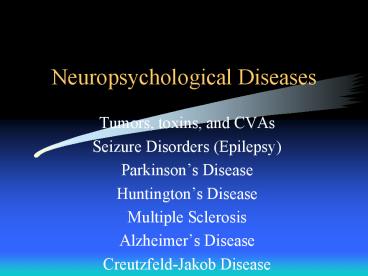Neuropsychological Diseases PowerPoint PPT Presentation
1 / 13
Title: Neuropsychological Diseases
1
Neuropsychological Diseases
- Tumors, toxins, and CVAs
- Seizure Disorders (Epilepsy)
- Parkinsons Disease
- Huntingtons Disease
- Multiple Sclerosis
- Alzheimers Disease
- Creutzfeld-Jakob Disease
2
Seizure Disorders (Epilepsy)
- Seizures may be from trauma, illness, or drugs.
These are usually reversible. - Chronic seizure patterns generated by brain
dysfunction are called epilepsy.
3
Symptoms of epilepsy
- Convulsions
- Tremors or clonus
- Rigidity or tonus
- Loss of balance and consciousness
- High-amplitude EEG spikes
- Epileptic auras
- Provide clues to the location of the focus
- Provide warning of an impending seizure
4
Partial seizures
- Affect only part of the brain at a time
- May be simple or complex
- Simple partial (Jacksonian) seizures Spreading
sensory or motor or combined effects - Complex partial seizures or temporal lobe
epilepsy begin with an aura and lead to a
psychomotor attack automatisms with
consciousness but no recollection. Most common
variety 50 of all cases.
5
Generalized seizures
- Involve the entire brain, either by gradual
building or simultaneously, perhaps from a focus
in the thalamus. - Grand mal seizures
- Tonic-clonic convulsion
- Loss of consciousness and balance
- Hypoxia from excessive excitatory amino acids
6
Generalized seizures
- Petit mal or absence seizures
- 3-per-second spike-and-wave EEG pattern
1 second
Common in children, often end at puberty
Labelled daydreamers and space cadets.
7
Parkinsons disease
- Multiple causes genetic error, infection,
stroke, trauma, neurotoxins, idiopathic - Damage to substantia nigra in midbrain
- Normally dampens the responsiveness of the
caudate nucleus of the striatum of basal ganglia - Symptoms include resting tremor, difficulty
starting or stopping movement, flattened facial
expression or emotion. Intellect is intact.
8
Parkinsons disease
- Treatment
- L-DOPA (levorotatory dihydroxyphenylalanine)
- Deprenyl (selegeline, Eldepryl)
- Dose-dependent MAO-B Inhibitor
- May inhibit DA uptake at the synapse
- Metabolites include amphetamine and
methamphetamine, which inhibit uptake and
increase release of DA, NE, and 5-HT - Discovered through the MPTP episode.
9
Huntingtons disease
- Caused by a single dominant gene
- Progresses from fidgety motor behavior to chorea
to dementia to death - Symptoms start after age 40, last 15 years
- No cure, but a test is available.
10
Multiple sclerosis
- Scarred hardening (sclerosis) of myelin
- Hypothesized cause A slow-acting infection of
childhood leading to autoimmune reaction against
myelin, in genetically susceptible people - Disrupts sensation, especially vision and touch
- Produces weakness, tremor, ataxia, and loss of
bladder control
11
Alzheimers disease
- A progressive dementia associated with advancing
age, it affects about 10 of people over age 85. - Behavioral symptoms are similar in several of the
dementias Alzheimers diagnoses are confirmed
post-mortem by the presence of neurofibrillary
tangles and amyloid plaques - There is significant loss of neurons
12
Alzheimers disease
- Damage is greatest in the entorhinal cortex,
amygdala, and hippocampus, all in the medial
temporal lobe and all involved in memory and in
the temporal, parietal, and prefrontal cortex,
all involved in complex thought. - Genetic component on chromosome 21, 14, or 19
produces 50 risk in immediate family members who
live to be 80 - 100.
13
Transmissible Spongiform Encephalopathies
Creutzfeld-Jakob Disease and Mad Cow Disease
- A viral infection, CJD comes in two forms
- Variant CJD has been linked with mad cow disease
which has claimed a number of lives in the United
Kingdom. - The other strain, typical CJD, has a 30-year
incubation period, so normally occurs in older
people.

